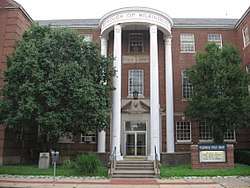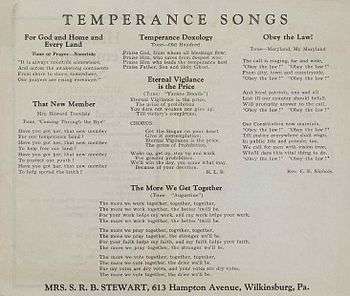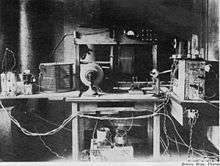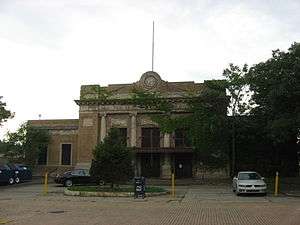Wilkinsburg, Pennsylvania
Wilkinsburg is a borough in Allegheny County, Pennsylvania, United States, with an official population of 15,930. Wilkinsburg is part of the Pittsburgh metropolitan area, which has a population of 2,324,743, thus the largest metropolitan area in both the Ohio Valley and Appalachia, and also the second-largest in Pennsylvania (behind Philadelphia), and the 27th-largest in the United States. Wilkinsburg is adjacent to five neighborhoods of the city of Pittsburgh and borders four other boroughs and one township. The population of Wilkinsburg was 15,930, according to the 2010 census,[3] having declined by 13,923 official residents in the 70 years since the 1940 census, when 29,853 people were enumerated. The borough of Wilkinsburg was named for John Wilkins, Jr., a United States Army officer who served as Quartermaster General of the United States Army from 1796 to 1802.[4]
Wilkinsburg | |
|---|---|
 Entrance to Wilkinsburg's municipal building and library, 605 Ross Avenue | |
 Location in Allegheny County and the U.S. state of Pennsylvania. | |
 Wilkinsburg Location in Allegheny County and the U.S. state of Pennsylvania.  Wilkinsburg Wilkinsburg (the United States) | |
| Coordinates: 40°26′38″N 79°52′39″W | |
| Country | United States |
| State | Pennsylvania |
| County | Allegheny |
| Area | |
| • Total | 2.25 sq mi (5.83 km2) |
| • Land | 2.25 sq mi (5.83 km2) |
| • Water | 0.00 sq mi (0.00 km2) |
| Population (2010) | |
| • Total | 15,930 |
| • Estimate (2019)[2] | 15,292 |
| • Density | 6,793.43/sq mi (2,622.80/km2) |
| Time zone | UTC-5 (Eastern (EST)) |
| • Summer (DST) | UTC-4 (EDT) |
| FIPS code | 42-85188 |
| Website | Official website |
History
Located on a major land road or pathway (now known as Penn Avenue), in the natural transportation nexus region where the Allegheny River and the Monongahela River join to form the Ohio River, the Pittsburgh area had been inhabited by Native Americans for thousands of years. In the early 1700s European traders arrived, and colonial settlements established by mid century. Subsequently, the area was subject to the French and Indian Wars. In the 1800s trade began to be supplemented by major mining and manufacturing operations, and the area population continued to grow rapidly from the late 1800s and the early 1900s, with numerous immigrants from Europe and African Americans of the Great Migration from the Southern United States.
The Land Company of the Colony of Pennsylvania began to offer deeds in the general area which was to become Wilkinsburg, in 1769. Andrew Levi Levy, Sr. purchased 266 acres of woodland, to which he officially gave the name of Africa (for reasons which remain obscure).[5] In 1788, Levy sold his deed to William Thompson (a retired brigadier general who had served in the Continental Army during the American Revolutionary War). Thompson died shortly after, and the land was sold to Col. Dunning Mcnair (the father of Dunning R. McNair, who would become the Sergeant at Arms of the United States Senate, 1853-1861).[6]
In 1790, Dunning McNair laid out a village called McNairstown on the "Great Road" later known as Penn Avenue.[7] By 1812, the village was referred to as "Wilkinsburgh" in honor of John Wilkins Jr.[8] The City of Pittsburgh in 1873 annexed a portion of Wilkins Township containing Wilkinsburg, but less than three years later, a legal action reversed the annexation.[9] On October 5, 1887, Wilkinsburg separated from the recently created Sterrett Township to become an independent borough.[10]
Place of religion

Wilkinsburg was founded and developed by highly religious European immigrants. The borough has a remarkably high concentration of churches, mostly Protestant, which is unusual in a predominantly Catholic region of the country. According to borough leader James Kelly, the reversal of Wilkinsburg's annexation to Pittsburgh in the 1870s was in order to maintain the religious integrity of the community. Wilkinsburg was known during this time by many as "The Holy City".
Public library
In 1899 the Wilkinsburg library was founded as a branch of the Braddock library (which was the first of the Carnegie libraries in the nation). The Wilkinsburg library also serves as a meeting place for council members as well as being the home of the local police department.[11]
Home of modern broadcasting

Wilkinsburg won a note in the history of radio broadcasting, when resident Frank Conrad spearheaded a radio laboratory at his home in Wilkinsburg, coordinated with Westinghouse Electric Corporation and the United States Signal Corps, under a special war time permit (using call signs 2-WM and 2-WE).[12] After moving from Swissvale to Wilkinsburg, Conrad installed a radio station on the top floor of his backyard two-story garage, with a microphone, where he worked into the wee hours of the morning, eventually resulting in the development of modern broadcasting, as do it yourself listeners who had made their own crystal radio sets began to respond, some quite enthused by the music broadcast when Frank Conrad coupled a phonograph to radio. Wilkinsburg thus became the original location for modern broadcasting, combining the concepts of "the station, the audience, the programs, and a means to pay for the programs", after Conrad accepted a donation from a Wilkinsburg music store to promote its musical offerings[13] This was all before and leading up to KDKA and the development of commercial radio.[14] In 1916, the world's first commercially licensed radio station KDKA began broadcasting as experimental station 8XK from studios of Westinghouse in East Pittsburgh and in a small garage owned by Frank Conrad, before it was launched with its current call letters on November 2, 1920. In 1923, Wilkinsburg-based Russian immigrant Vladimir Zworykin designed and patented the iconoscope, the photocell "eye" of early television cameras. Today, ABC affiliate WTAE-TV is located in the borough on Ardmore Boulevard.
Current development
Although the borough has been economically depressed in recent years, many efforts are being made to change this. In 2004, the Pittsburgh History and Landmarks Foundation launched initiatives in partnership with its for-profit development affiliate, Landmark Development Corporation, to begin restoration work on historic structures in Wilkinsburg's Hamnett Place neighborhood. Within a decade, more than 70 structures were improved, a new neighborhood center was opened, and the community's supply of affordable housing was increased. The collaborators were subsequently honored with the Richard H. Driehaus Foundation National Preservation Award in recognition of their accomplishments.[15][16] During this time, the Hamnett Historic District was also established; that historic district was then approved on June 28, 2010 for listing on the National Register of Historic Places.[17]
In 2015, the Pittsburgh History and Landmarks Foundation and its for-profit affiliate, Landmark Development Corporation, entered into a collaboration with Falconhurst Development to begin an $11.5 million multi-site restoration within and near the Hamnett Historic District. In addition to restoring four vacant buildings which had been built sometime around the beginning of the 20th century, the developer had plans to open a series of new townhouses in the same area by 2016 with the collaborators again indicating that the housing would be affordable, based on United States Housing and Urban Development Department (HUD) guidelines. Ground was broken on the project in late September 2015.[18]
Wilkinsburg Community Development Center
The Wilkinsburg Community Development Center (WCDC, open since 2008) on Wood Street has become a huge part in bringing positive change to the neighborhood through helping local businesses move in, spreading the word about events going on, and bringing the people of Wilkinsburg together.[19]
Geography

According to the United States Census Bureau, the borough has a total area of 2.3 square miles (6.0 km2), all of it land.
Surrounding neighborhoods
Wilkinsburg has ten borders, including Penn Hills Township to the northeast, Churchill to the east, Forest Hills to the southeast, Edgewood to the south, Swissvale to the southwest, and the Pittsburgh neighborhoods of Regent Square, Point Breeze, and North Point Breeze to the west, Homewood South to the northwest, and East Hills to the north.
Parks and recreation
Wilkinsburg has several parks, of various sizes. The largest is Hunter Park, which at almost nine acres includes sports courts, fields, playground equipment, and woodland. There are also six smaller parks.
Demographics
| Historical population | |||
|---|---|---|---|
| Census | Pop. | %± | |
| 1880 | 1,529 | — | |
| 1890 | 4,662 | 204.9% | |
| 1900 | 11,886 | 155.0% | |
| 1910 | 18,924 | 59.2% | |
| 1920 | 24,403 | 29.0% | |
| 1930 | 29,639 | 21.5% | |
| 1940 | 29,853 | 0.7% | |
| 1950 | 31,418 | 5.2% | |
| 1960 | 30,066 | −4.3% | |
| 1970 | 26,780 | −10.9% | |
| 1980 | 23,669 | −11.6% | |
| 1990 | 21,080 | −10.9% | |
| 2000 | 19,196 | −8.9% | |
| 2010 | 15,930 | −17.0% | |
| Est. 2019 | 15,292 | [2] | −4.0% |
| Sources:[20][21][22][23] | |||
As of the census[22] of 2000, there were 19,196 people, 9,138 households, and 4,477 families residing in the borough. The population density was 8,335.1 people per square mile (3,222.4/km²). There were 10,696 housing units at an average density of 4,644.3 per square mile (1,795.5/km²). The racial makeup of the borough was 29.25% White, 66.51% African American, 0.38% Native American, 0.81% Asian, 0.06% Pacific Islander, 0.55% from other races, and 2.44% from two or more races. Hispanic or Latino of any race were 1.13% of the population.
There were 9,138 households, out of which 22.6% had children under the age of 18 living with them, 24.3% were married couples living together, 20.7% had a female householder with no husband present, and 51.0% were non-families. 44.5% of all households were made up of individuals, and 12.5% had someone living alone who was 65 years of age or older. The average household size was 2.06 and the average family size was 2.91.
In the borough the population was spread out, with 23.4% under the age of 18, 7.7% from 18 to 24, 30.0% from 25 to 44, 23.1% from 45 to 64, and 15.8% who were 65 years of age or older. The median age was 38 years. For every 100 females there were 78.5 males. For every 100 females age 18 and over, there were 72.0 males.
The median income for a household in the borough was $26,621, and the median income for a family was $33,412. Males had a median income of $26,813 versus $26,196 for females. The per capita income for the borough was $16,890. About 15.9% of families and 18.7% of the population were below the poverty line, including 30.8% of those under age 18 and 14.2% of those age 65 or over.
Education
In its early history, education in Wilkinsburg was completely private. Many schools were started by different teachers and held in their homes. The Wilkinsburg Academy, founded in 1852, was the beginning of large-scale schooling. The Free Common School Act of 1834 was adopted by the borough in 1840; James Kelly loaned money for the first common school which served until 1850. From this time, the number of students rose exponentially. By 1910, there were 4,253 students in six public schools.[24] Today, Wilkinsburg School District consists of Kelly Elementary and Turner Elementary schools. Due to lack of funding, Wilkinsburg's Junior and Senior High schools recently closed. The district now outsources Junior and Senior High School education to Westinghouse High School in the Pittsburgh Public School district. The graduating class of 2016 was the last to graduate from Wilkinsburg High School.
Wilkinsburg is also home to the Sister Thea Bowman Catholic Academy. This is a Catholic elementary school which was formed as a merger of St. James School in Wilkinsburg and Holy Rosary in Homewood (Pittsburgh). The new school is housed in the former St. James School building and educates children from pre-kindergarten through eighth grade.
Government and Politics
| Year | Republican | Democratic | Third Parties |
|---|---|---|---|
| 2016 | 8% 628 | 91% 7,341 | 1% 121 |
| 2012 | 9% 747 | 90% 7,876 | 1% 86 |
Wilkinsburg is a borough, located in the U.S. Commonwealth of Pennsylvania; which means that Wilkinsburg is a self-governing municipal entity, of the sort often thought of as a town. Wilkinsburg Borough is organized as three wards: First, Second, and Third.
Local government
Overall oversight of Wilkinsburg Borough is by the Burough Council. The Borough Council generally consists of nine elected representatives, three from each ward. Wilkinsburg has or has associated various Boards, Committees, and Authorities. Wilkinsburg also has a Mayor and a Borough Manager.
Wilkinsburg Borough Authorities, Boards, and Commissions include the Civil Service Commission, the Community Art and Civic Design Commission, the Citizens Advisory Commission on Shade Trees, the Parks and Recreation Advisory Board, the Planning Commission, the Zoning Hearing Board, the Board of Library Directors, the Industrial and Commercial Development Authority, and the Municipal Authority.
Public education board
Public education is handled by the Wilkinsburg School District's Board of Directors, in combination with the Pennsylvania State Board of Education, the Pennsylvania Department of Education, and the Pennsylvania General Assembly. The domain of public education is separate from that of the Borough.
Water and sewage authority
Wilkinsburg water and sewage services are provided through a Municipal Authority, the Wilkinsburg-Penn Joint Water Authority, a coalition serving several communities. The Wilkinsburg Borough Council appoints 3 members to the Board.
National political alignment
Wilkinsburg voters voted predominantly for the Democratic Party, in the 2012 and 2016 presidential elections.
Arts and culture
Wilkinsburg Borough has a Community Art and Civic Design Commission charged with review and legislation for "new and renovated structures, infrastructure, landscapes, works of art, memorials, and monuments on all public property and on all private property designated for commercial use." [27] Due to its location in Allegheny County, and especially its proximity to Pittsburgh, Wilkinsburg is in the neighborhood for numerous opportunities for experiences in art and culture.
Community Development and Revitalization
The most notable agent of revitalization and development in Wilkinsburg is the Wilkinsburg Community Development Corporation (WCDC), a non-profit incorporated in 2007 with a mission "to promote the revitalization of Wilkinsburg through business & residential development; organizational & individual civic leadership; and ethnic & cultural diversity".[28] Their notable community programs include classes for local entrepreneurs, classes on home buying, community events and the Vacant Home Tour. The WCDC focuses primarily on the Wilkinsburg Business District, the area around the intersection of Penn Avenue and Wood Street. The WCDC's Business District Revitalization Plan aims to promote a "flourishing commercial and retail environment in Wilkinsburg" and consists of planning and policy recommendations.[29] In May 2015, the WCDC's advocacy resulted in an approved liquor license referendum, legalizing the sale of up to five restaurant liquor licenses in the borough, which had been a dry community since 1935.[30]
Violent Crime
Various violent crimes have occurred in Wilkinsburg. Major examples date to the 1990s, 2000, and 2016.
Wilkinsburg was home to the infamous Larimer Avenue-Wilkinsburg (LAW) Gang, which was indicted by the federal government under the Racketeer Influenced and Corrupt Organizations Act (RICO). The indictment started in 1995, when the federal government began to investigate and arrest many people with criminal ties or activities. Overall crime in Wilkinsburg is higher than outlying neighborhoods on average, but crime has seen a slight decline in recent years.[31][32]
On March 1, 2000, Wilkinsburg received national attention when Ronald Taylor, a man suffering from schizophrenia, killed three people and wounded two others in a spree that occurred in part at the local Burger King and McDonald's restaurants.[33]
On March 9, 2016, five people were killed including a pregnant woman in a shooting at a cook-out in Wilkinsburg. In light of this, Rebuilding Together Pittsburgh is planning to take steps in helping those living in the neighborhood move past the event by revitalizing the area around where the shooting took place. The City Council has many plans to beautify the neighborhood and repair many of the vacant homes such as the apartment building on 855 Rebecca Avenue.[34] Furthermore, Vice President of the City Council recently started Wilkinsburg Community Conversations, whereby community members have the opportunity to discuss current issues the borough is facing.[35][36][37][38]
Transportation
History
Until September 14, 1975, Wilkinsburg had inter-city passenger rail service. On that day Amtrak discontinued service, citing a total of 128 passengers boarding or alighting in the first six months of 1975, the lowest system-wide. The last train serving Wilkinsburg was the National Limited, which operated daily between New York City and Kansas City, Missouri.[39] The PennDOT-operated Parkway Limited provided commuter service to Pittsburgh for nine months in 1981 but was also canceled because of low ridership.[40][41]
Current
Wilkinsburg has multiple stations on the Martin Luther King Jr. East Busway:
- Wilkinsburg
- Hamnett
Notable people
- Les Biederman (1907–1981), sports writer, columnist and editor for the Pittsburgh Press
- Daniel Carter, jazz musician
- Frank Conrad, radio broadcast pioneer
- Charlie Deal, Major League Baseball infielder for Chicago Cubs
- Richard Frankenburg (1929–2015), former Republican member of the Pennsylvania House of Representatives
- Vic Fusia (1916–1992), American football player and coach
- Dick Groat, All-American college basketball player, and shortstop for the 1960 World Series winning Pittsburgh Pirates baseball team
- Amzi D. Harmon (1845–1927), Medal of Honor recipient in the American Civil War[42]
- Bob Hoffman (1898–1985), weightlifter and bodybuilder
- Kimmarie Johnson, actress, model, businesswoman and beauty pageant titleholder
- Bill McKechnie, baseball player and manager
- M. Graham Netting, herpetologist and conservationist
- Dunning R. McNair, Sergeant at Arms of the United States Senate from March 17, 1853 to July 6, 1861
- Edward Ormondroyd, author
- Bunny Yeager, photographer and model
- Ralph "Brigham" Young (1898–1967), politician
See also
- AM broadcasting, much of which first developed in Wilkinsburg
- Blackridge, Pennsylvania, a community located in the municipalities of Wilkinsburg, Penn Hills and Churchill
- Hamnett Historic District, Wilkinsburg, Pennsylvania
- John F. Singer House, a historical building
- List of Pittsburgh History and Landmarks Foundation Historic Landmarks, which includes the Wilkinsburg "1939 House" designed by Dwight James Baum
- Radio broadcasting
- Scholastic Corporation, now head-quartered in New York City, but started up in Wilkinsburg
- Wilkinsburg School District
- Wilkinsburg station
- Wilkinsburg station (PAAC)
References
- "2019 U.S. Gazetteer Files". United States Census Bureau. Retrieved July 28, 2020.
- "Population and Housing Unit Estimates". United States Census Bureau. May 24, 2020. Retrieved May 27, 2020.
- "Race, Hispanic or Latino, Age, and Housing Occupancy: 2010 Census Redistricting Data (Public Law 94-171) Summary File (QT-PL), Wilkinsburg borough, Pennsylvania". United States Census Bureau. Retrieved September 26, 2011.
- Porter, Thomas J. Jr. (May 10, 1984). "Town names carry a little bit of history". Pittsburgh Post-Gazette. p. 1. Retrieved 26 May 2015.
- Wilkinsburg Historical Society (2007) Wilkinsburg, Arcadia Publishing, 9. The map on page 10 shows his name as Levi Andrew Levy, Sr.
- Wilkinsburg Historical Society (2007) Wilkinsburg, Arcadia Publishing, 9.
- "A Detailed History". Wilkinsburg Borough. Retrieved 24 March 2020.
- Wilkinsburg Historical Society (2007). Wilkinsburg. Images of America. Arcadia Publishing. p. 9. ISBN 0-7385-4917-7.
- Davison, Elizabeth M.; McKee, Ellen B., eds. (1940). Annals of Old Wilkinsburg and Vicinity. Wilkinsburg, PA: Group for Historical Research. pp. 469–473.
- Davison, Elizabeth M.; McKee, Ellen B., eds. (1940). Annals of Old Wilkinsburg and Vicinity. Wilkinsburg, PA: Group for Historical Research. pp. 540, 545.
- "Wilkinsburg Public Library : About Us". www.wilkinsburglibrary.org. Retrieved 2016-06-07.
- "The Early History of Broadcasting in the United States" by H. P. Davis, included in The Radio Industry: The Story of Its Development, 1928, pages 191-192.
- "Frank Conrad: Sleepless Genius", National Museum of Broadcasting (nmbpgh.org)
- http://www.nmbpgh.org/conrad_project/historical_background/commercial.htm
- Sisson, Patrick. "How historic preservation rebuilt a Pittsburgh neighborhood: Brick house by brick house, the award-winning effort to restore Hamnett Place offers a roadmap for creating affordable housing." Philadelphia, Pennsylvania: Curbed, November 20, 2017.
- Martines, Jamie. "Wilkinsburg continues efforts to overcome blight, renew itself." Pittsburgh, Pennsylvania: TribLive, August 10, 2018.
- "National Register of Historic Places; Notification of Pending Nominations and Related Actions," in Federal Register, June 8, 2010, pp. 32502-32503. Washington, D.C.: National Archives and Records Administration, retrieved online September 30, 2019.
- Beras, Erika. "Restoration Begins on Historic Wilkinsburg Housing." Pittsburgh, Pennsylvania: WESA Radio (PBS), September 28, 2015.
- Daniels, Diane I. (2016-01-14). "Revitalization underway…Wilkinsburg strives to strengthen business community". New Pittsburgh Courier. Retrieved 2016-06-07.
- "Number of Inhabitants: Pennsylvania" (PDF). 18th Census of the United States. U.S. Census Bureau. Retrieved 22 November 2013.
- "Pennsylvania: Population and Housing Unit Counts" (PDF). U.S. Census Bureau. Retrieved 22 November 2013.
- "U.S. Census website". United States Census Bureau. Retrieved 2008-01-31.
- "Annual Estimates of the Resident Population". U.S. Census Bureau. Retrieved 22 November 2013.
- Wilkinsburg Historical Society (2007). Wilkinsburg: Images of America. Charleston, SC: Arcadia Pub. pp. 35–50. ISBN 0-7385-4917-7.
- EL. "2012 Allegheny County election". Pittsburgh Tribune-Review. Retrieved 15 October 2017.
- EL. "2016 Pennsylvani general election..." Pittsburgh Post-Gazette. Retrieved 15 October 2017.
- Wilkinsburg Borough official site, "Boards, Committees, and Authorities", accessed 23 January 2020
- "ABOUT WCDC - Wilkinsburg Community Development Corporation". Wilkinsburg Community Development Corporation. Retrieved 2016-06-07.
- "BUSINESS DISTRICT REVITALIZATION - Wilkinsburg Community Development Corporation". Wilkinsburg Community Development Corporation. Retrieved 2016-06-07.
- Schaeffer, Katherine. "'Dry' no more: Wilkinsburg, Bellevue restaurant owners expect to benefit". TribLIVE.com. Retrieved 2016-06-07.
- "Crime in Wilkinsburg, Pennsylvania (PA): murders, rapes, robberies, assaults, burglaries, thefts, auto thefts, arson, law enforcement employees, police officers, crime map". www.city-data.com. Retrieved 2016-06-07.
- "RICO Comes to Town", Pittsburgh Business Times (1998)
- Article at DigitalDuke
- "Neighbors Unite helps revitalize Wilkinsburg". Pittsburgh Post-Gazette. Retrieved 2016-06-07.
- "COMMUNITY CONVERSATIONS". Marita Garrett. Retrieved 2016-06-07.
- Stroud, Matt; Rosenberg, Eli (March 10, 2016). "Gunmen Open Fire on Backyard Party Near Pittsburgh, Killing 5". The New York Times. Retrieved March 10, 2016.
- Botelho, Greg (March 10, 2016). "6 dead, including pregnant woman, in Pennsylvania backyard shooting". CNN. Retrieved March 10, 2016.
- Goldstein, Andrew; Kane, Karen; Templeton, Dave; Czebiniak, Madasyn; Majors, Dan (March 10, 2016). "DA says Wilkinsburg ambush that killed six was planned, calculated, brutal". Pittsburgh Post-Gazette. Retrieved March 10, 2016.
- "Wilkinsburg Rail Stop To End, Amtrak Says". Pittsburgh Press. September 9, 1975. Retrieved 2010-09-08.
- Fisher, Ken (March 3, 1981). "Commuters gear up for Parkway work". Pittsburgh Post-Gazette. Retrieved 2010-09-08.
- Bowman, Lee (November 14, 1981). "Riders Bid Farewell To 'Parkway Limited'". Pittsburgh Press. Retrieved 2010-09-08.
- "Amzi D. Harmon". Retrieved August 10, 2014.


